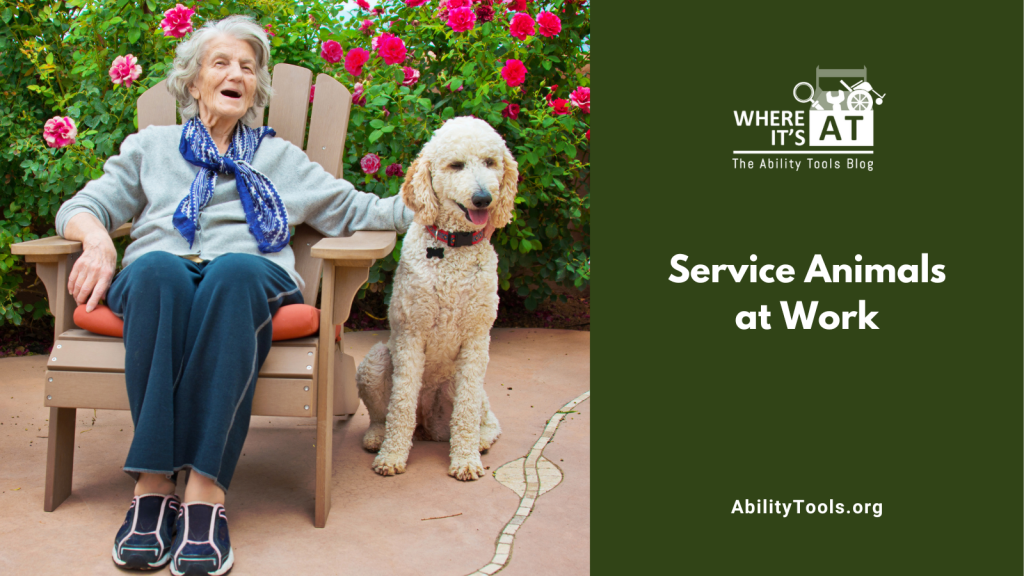The importance of the bond between humans and animals is undeniable. Many studies have shown the value of that bond in the form of mental, physical and even social health, but some of our animal friends are talented and caring enough to be capable of taking on the responsibility of becoming service animals.

Service animals, as defined by the ADA, are dogs specially trained to perform very specific tasks that could otherwise be difficult or even impossible for people with disabilities to perform independently, and as such, their training must be directly related to the person’s disability.
Although there has been great success with horses/miniature horses and even pigs providing care, by the ADA definition, they are not considered service animals. This is not to diminish the anxiety reducing skill and relief that emotional support animals provide their humans, regardless of type, but they are not considered service animals, as they are not specifically trained to perform a specific task related to a disability. They are therefore not eligible to the same privileges ensured to service animals and their humans. If you want to deep dive on some of the more commonly asked questions, you can visit the Frequently Asked Questions about Service Animals and the ADA webpage at ADA.gov.
- Allergy Alert Dogs are trained to detect allergens specifically related to their human, and alert their humans to their presence.
- Autism Service Dogs are trained to aid in social settings. Not only do they serve as support in social settings with their human’s peers, they also aid in comfort with socialization because they interact with their human on unconditional terms, so their human can be comfortable and themselves around their dog, without the pressures of sometimes judgmental human interaction.
- Diabetic Alert Dogs aka Glucose Alert Dogs are trained to sniff the breath of their human and alert at the presence of dangerous blood sugar highs (hyperglycemia) and lows (hypoglycemia) so medication and additional safety measures can be taken.
- FASD or DE Assistance Dogs are trained to support the needs of individuals diagnosed with fetal alcohol spectrum (FASD) and/or drug exposure (DE). Their tasks can be similar to Autism Service dogs, such as; interrupting compulsive thought patterns, supporting in social interaction and calming anxiety.
- Guide Dogs, probably the most well-known service animals, are trained to support people with vision-based disabilities, helping people navigate physical environments.
- Hearing Dogs are trained to support people with hearing-based disabilities and can alert their humans to alarms and even baby cries.
- Mobility Assistance Dogs are trained to bring objects to their humans, open doors or provide stability for those needing ambulatory assistance.
- Psychiatric Service Dogs are trained to support individuals with PTSD, schizophrenia, anxiety and more, learning tasks specific to their human’s needs, like dissuading from harmful behaviors or “clearing” rooms before their human enters, ensuring that any hallucinations their human might be experiencing are not real.
- Seizure Response Dogs are trained to provide support to their humans when seizures occur. They can alert emergency response personnel, bring medication or adjust the body of the person into a safe position. Related to Seizure Response Dogs, Seizure Alert Dogs are a point of contention among the community of people involved in service animal work. Many assert that dogs cannot predict a seizure, while some assert that they do.
The ADA does not restrict any type of dog breed, and good thing, because there is no such thing as the perfect service dog breed. Some breeds are more universally successful than others, those breeds tending to be working breeds who are already inclined to be alert and active and trainable. They tend to be smarter breeds, as this certainly makes the training of specific tasks less arduous. And they also tend to be more friendly and patient, as they will likely have far more social encounters than any other non-service dogs. This list can include breeds like; Border Collies, Portuguese Water Dogs, Boxers and Poodles. Let’s take a look at a few more common service dog types and their potentially unique skill sets.
- Golden Retrievers – their above average sense of smell can be of particular benefit to those in need of allergy alert dogs, who are trained to detect allergens specific to the individual and alert the person of the danger.
- Great Danes – their size can be of particular benefit to those in need of mobility assistance dogs, as the individual can balance themselves against this large and sturdy breed.
- Labrador Retrievers – their retrieving skills can be of particular benefit to those in need of mobility assistance dogs, as they are skilled in discovering and retrieving objects for their human who might need assistance in opening doors or readily obtaining objects independently.
- Pomeranians – their size can be of particular benefit to those in need of Diabetic alert dogs, as the dog is small enough that it can be more easily be closely carried so the dog can smell the breath of the individual and be able to alert them of changes in glucose levels.
But remember, there are no limits on dog breeds, so just because your dog might not be listed in this very truncated list, does not mean that they won’t train successfully. That will get down to you, your dog, and your trainer.




